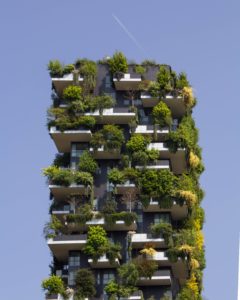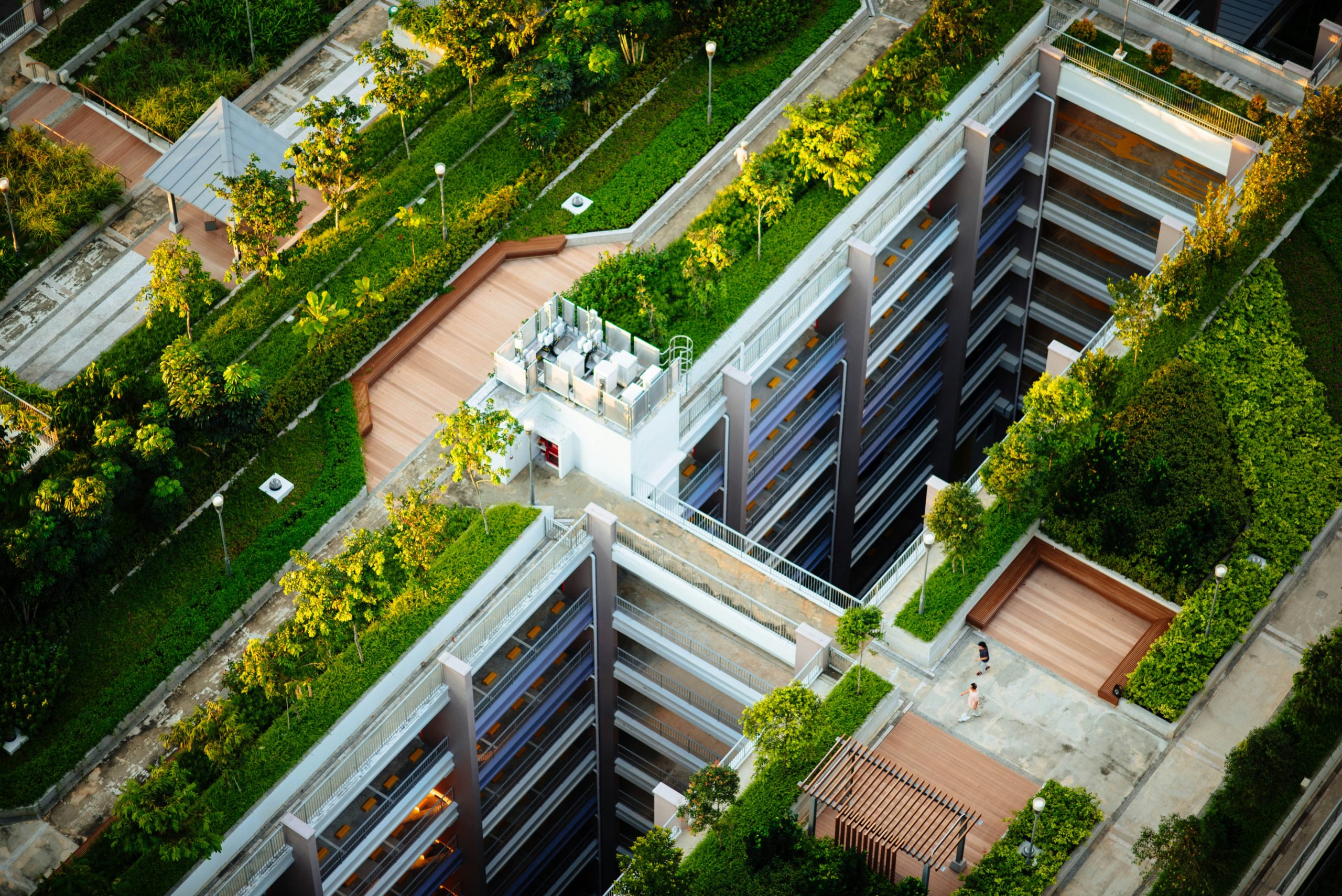Why is it important?
Every year in Europe, 450 km2 of land is turned into urban construction like roads or buildings, with a 6% increase of built areas between 2000 and 2018 (1).
While land use change contributes to greenhouse gas emission, land artificialisation reduces soil organic quality and limits ecosystems resilience such as natural carbon storage (12) or water natural regulation. The consequence is increasing floods, but also air, water and soil pollution (2).
In addition, urbanisation reduces and fragments habitats and reduces biodiversity (2). Biodiversity loss has an indirect but dramatic impact on human health and possible pandemics (3). The global demographic pressure affects biodiversity (4), and it is predicted that by 2050, 1/3 of vertebrate will be impacted by urban expansion and habitat fragmentation (5). The IPCC warns that to preserve vital ecosystem services, the protection of biodiversity requires the conservation of 30 to 50% of land, oceans and freshwater (6).
What is the solution?
It is possible to conserve, protect or preserve nature in urban settings.
The first step is to preserve natural parcels from artificialisation and avoid turning natural land into sealed-soil area. Adopt ecological planning strategies (10) in universities, hospitals or urban settings to create more green spaces and cradles for fauna and maintain green spaces naturally without chemicals. When space is lacking, green buildings with walls or roofs covered by natural plants is also an option. Preserving land from waste contamination is key and, when possible, rewilding urbanised areas by letting nature take it back, is an impactful step too.
Reconnect to nature has also a positive effect on human well-being and health (7).
Point of attention
In some countries, wild green spaces can become a health hazard for humans, with snakes, spiders or other life-threatening fauna. In such cases, preserving biodiversity should be carefully considered.
Key actions
-
#1 Avoid new land artificialisation
Avoid artificialisation of new parcels. Favour renovation of existing structures instead of new construction. Solutions exist to create green parking spaces allowing water to percolate through the soil without oily matters.
-
#2 Maintain green areas using sustainable and natural strategies
Eco-friendly maintenance practices protect green areas: rainwater irrigation, natural fertilisers like compost to increase the number of vital microorganisms in the soil, and natural pesticides and herbicides (14, 16). Limit lawn mowing to avoid habitat destruction of organisms living in the ground and leave twigs and leaf piles (15).
-
#3 Create and enlarge green spaces: healing gardens, therapeutic landscapes, and recreational gardens
Green spaces offer a place to connect with nature, contributing to physical and mental well-being while preserving and enriching local biodiversity. Use native and seasonal vegetation to support local biodiversity.
-
#4 Create welcoming areas for local fauna
Establish inviting habitats through the installation of artificial hives, nests, shelters, perches, and food stations to attract wildlife and crucial pollinators, integrating native and seasonal plants (14, 15). Prevent habitat fragmentation to maintain ecological continuity. Enhance wildlife mobility by promoting the connectivity of natural habitats.
-
#5 Create green buildings
Creating roof gardens and living walls in hospital and university buildings using native and resilient species will attract organisms such as pollinators, essential to maintain healthy lands around the buildings. See Green Building factsheet.
-
#6 Rewild
When possible, give land back to nature and “rewild” land or dedicated areas in a garden by removing concrete layers and letting plants grow freely. Remove asphalt and re-plant, where possible.
To consider
-
Potential co-benefits
- Improved well-being: connecting with nature promotes well-being (7).
- Social benefits: Green areas improve air quality (12).
- Economic benefits: green spaces speed up health recovery, reduce the use of pain killers and reduce healthcare costs (11).
- Cooling temperatures: Preserving healthy green spaces around hospitals and universities contributes to cooling premises and urban areas by mitigating the heat island effect (13).
- Encourage soft mobility: Green spaces can create safer areas for walking and cycling, encouraging low-emission transport (17).
- Social contacts: green spaces enhance social contacts, cohesion, and creativity (18).
-
Success conditions
- Involvement of management team.
- Inform, sensitise and educate staff, procurement teams, suppliers, beneficiaries, students and patients.
-
Prerequisites & specificities
- Respecting the native ecosystem and adapt to local species.
- Making sure not to introduce invasive species.
-
Potential risks
- Indoor hospital garden projects require thorough evaluation to minimise contamination from the flora and fauna and reduce the risk of infections. (19)
- Green wild areas in human settings can attract health threatening fauna like snakes.
Tools and good practices
-
Nature positive University Network
500 universities around the world created a network to protect, restore and conserve nature and biodiversity, in partnership with the UN Decade on Ecosystem Restoration
Explore here -
Ecosystem restoration playbook
UNEP guideline proposing solutions to restore ecosystems in towns and cities (among others).
Explore here -
Regreen project and resources
Regreen is a consortium of universities, research, cities and consultant agencies promoting nature-based solutions in Europe and China to renature cities.
Explore here -
Video about ecosystem services
Eurac Research produced a short video explaining what ecosystem services are.
Explore here -
Adding biodiversity to your garden, Missouri University, 2023
10 pieces of advice to create gardens with more biodiversity
Explore here
To go further
-
Policy Brief: Urban Nature and Biodiversity, the World Bank, 2021
Policy brief explaining how the ecological planning strategy can help protect biodiversity in an urban context.
Explore here -
Intergovernmental Science-Policy Platform on Biodiversity and Ecosystem Services
The Intergovernmental Science-Policy Platform on Biodiversity and Ecosystem Services (IPBES) is an independent intergovernmental body established in 2012 by 94 states. It aims at reinforcing the link between science and policies about biodiversity and ecosystem services.
Explore here -
Botanic Gardens: Using biodiversity to improve human wellbeing, Botanic Gardens Conservation International, 2006
Report summarising past work with botanical gardens in the context of human-well-being. It focuses on how these gardens around the globe support communities, nutrition, healthcare and financial poverty.
Explore here -
Comprehensive plant list and where they thrive (including plants suitable for urban areas), Wild Seed Project, 2023
Explore here -
Growing greener (podcast)
Weekly podcast that provides different solutions to make green spaces “healthier, more beautiful and more fun”.
Explore here
Sources
(1) European Environment Agency. Land take in Functional Urban Areas, 2012-2018 — European Environment Agency [Internet]. eea.europa.eu. 2021. Available here.
(2) European Environment Agency . Land take and net land take — European Environment Agency [Internet]. www.eea.europa.eu. 2019. Available here.
(3) Robin MM. La fabrique des pandémies. Editions La découverte. Série Cahiers libres; 2021 [cited 2024 Feb 26]. Available here.
(4) Laurance WF, Engert J. Sprawling cities are rapidly encroaching on Earth’s biodiversity. Proceedings of the National Academy of Sciences. 2022 Mar 31;119(16).
(5) Simkin RD, Seto KC, McDonald RI, Jetz W. Biodiversity impacts and conservation implications of urban land expansion projected to 2050. Proceedings of the National Academy of Sciences of the United States of America [Internet]. 2022 Mar 22;119(12). Available here.
(6) IPCC. SIXTH ASSESSMENT REPORT Working Group II -Impacts, Adaptation and Vulnerability Observed impacts [Internet]. 2022 Nov. Available here.
(7) White MP, Elliott LR, Grellier J, Economou T, Bell S, Bratman GN, et al. Associations between green/blue spaces and mental health across 18 countries. Scientific Reports. 2021 Apr 26;11(1):8903.
(8) IPCC, 2019: Climate Change and Land: an IPCC special report on climate change, desertification, land degradation, sustainable land management, food security, and greenhouse gas fluxes in terrestrial ecosystems [P.R. Shukla, J. Skea, E. Calvo Buendia, V. Masson-Delmotte, H.-O. Pörtner, D. C. Roberts, P. Zhai, R. Slade, S. Connors, R. van Diemen, M. Ferrat, E. Haughey, S. Luz, S. Neogi, M. Pathak, J. Petzold, J. Portugal Pereira, P. Vyas, E. Huntley, K. Kissick, M. Belkacemi, J. Malley, (eds.)]. In press. Available here.
(9) Bennett K. Getting started: Green spaces in healthcare [Internet]. IHF. 2023 [cited 2024 Feb 22]. Available here.
(10) The World Bank, The Natural Capital Project. Urban Nature and Biodiversity for Cities POLICY BRIEF [Internet]. 2021. Available from: https://www.thegpsc.org/sites/gpsc/files/final_urban_nature_and_biodiversity_for_cities.pdf
(11) NHS, Centre for sustainable Healthcare. What is the NHS Forest? [Internet]. NHS Forest. 2021 [cited 2024 Feb 19]. Available here.
(12) Ontl TA, Schulte LA. Soil Carbon Storage | Learn Science at Scitable [Internet]. Nature.com. 2012. Available here.
(13) Yang L, Qian F, Song DX, Zheng KJ. Research on Urban Heat-Island Effect. Procedia Engineering [Internet]. 2016;169(169):11–8. Available here.
(14) Tresch S, Frey D, Bayon RCL, Mäder P, Stehle B, Fliessbach A, et al. Direct and indirect effects of urban gardening on aboveground and belowground diversity influencing soil multifunctionality. Scientific Reports. 2019 Jul 5;9(1).
(15) Woodland Trust. How To Increase Biodiversity In Your Garden – Woodland Trust [Internet]. Woodland Trust. 2023. Available here.
(16) Wild Seed project. How to be an Ecological Gardener [Internet]. Wild Seed Project. 2023 [cited 2024 Feb 23]. Available here.
(17) Perry T, Nawaz R. An investigation into the extent and impacts of hard surfacing of domestic gardens in an area of Leeds, United Kingdom. Landscape and Urban Planning. 2008 May;86(1):1–13.
(18) WHO. How can we assess the benefits of urban nature? [Internet]. www.who.int. 2023 [cited 2024 Apr 3]. Available here.
(19) Surial B, Vázquez M, Steiger W, Rolli E, Brand S, Mühlethaler K, et al. Assessing the infection risk of a vertical garden in a hospital setting. Infection Control & Hospital Epidemiology [Internet]. 2022 Feb 1;43(2):273–5. Available here.
Featured
Green Building

Procurement criteria

Nature-friendly practices

Credits
Cover photo: Chuttersnap/Unsplash
